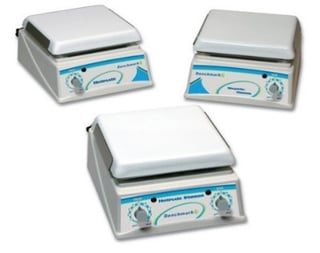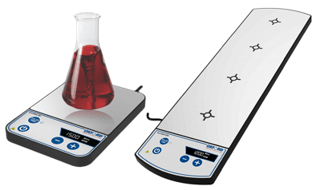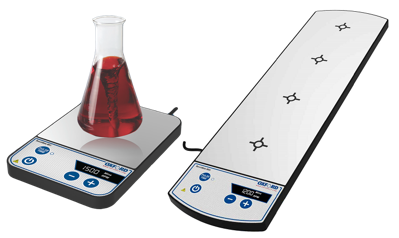Thinking back to the days of my first chemistry lab, I remember my favorite experiments being the ones involving hot plate magnetic stirrers, because who doesn’t love the ability to create a near instantaneous vortex of ridiculously hot liquid? Hotplate magnetic stirrers have played a critical role in many different types of laboratories since their original design precisely a century ago, but how do they work?
Hot plates:
Hot plates are a safer and more controllable alternative to Bunsen burners and other open flame apparatuses. To use, plug its power cord into an outlet, turn the dial or use buttons to select the temperature you wish your experiment to reach, and the platform heats up. Hot plates produce heat via joule heating, or running an electrical current through a medium with high electrical resistance. The resistance of the medium, metal coils in this case, makes it difficult for the electrons to pass through the circuit. The electrons slow down and collide with each other, and because the total energy of an enclosed system is always conserved, the kinetic energy of the electrons is “used up” and converted into heat energy. The speed of the electrons correlates to the amount of voltage put into the system. By controlling the input voltage, you also control the current and the amount of heat produced, and in turn, the temperature of the platform.
Magnetic Stirrers:

Long gone are the days of manually mixing solutions thanks to magnetic stirring units. As the name suggest, these units harness the power of magnetism for stirring purposes. A small magnetic bar coated in Teflon or glass, commonly referred to as a flea or stir bar, is submerged in the vessel containing the materials to be stirred. This vessel, usually made of glass, is placed on the stirring unit’s platform. Underneath the platform, a rotating magnetic field is created by either a rotating magnet or by running electric current through stationary electromagnets. The magnetic stir bar interacts with the rotating magnetic field and is always trying to align itself with the orientation of the field. Because the magnetic field is rotating, the flea must also rotate to stay in alignment. This rotation of the flea is responsible for the stirring action. By controlling the speed of the rotating magnet, or the amount of current passing through the electromagnets, you can control the rate at which the flea spins, and speed of the vortex created in the vessel.
If you are looking to purchase a hot plate, magnetic stirrer, or a combination unit, you will find some hot deals on them on here (http://www.pipette.com/magnetic-stirrers-hotplates)
If you are all mixed up and need help selecting which magnetic stirrer is right for you, be sure to read our blog post “How to pick the right magnetic stirrer for your lab”: (http://blog.pipette.com/how-to-pick-the-right-magnetic-stirrer-for-your-lab)
If you are getting heated up trying to decide which hot plate will suite your needs, check out our “Got the hots for hotplates” blog post:(http://blog.pipette.com/got-the-hots-for-hotplates)



